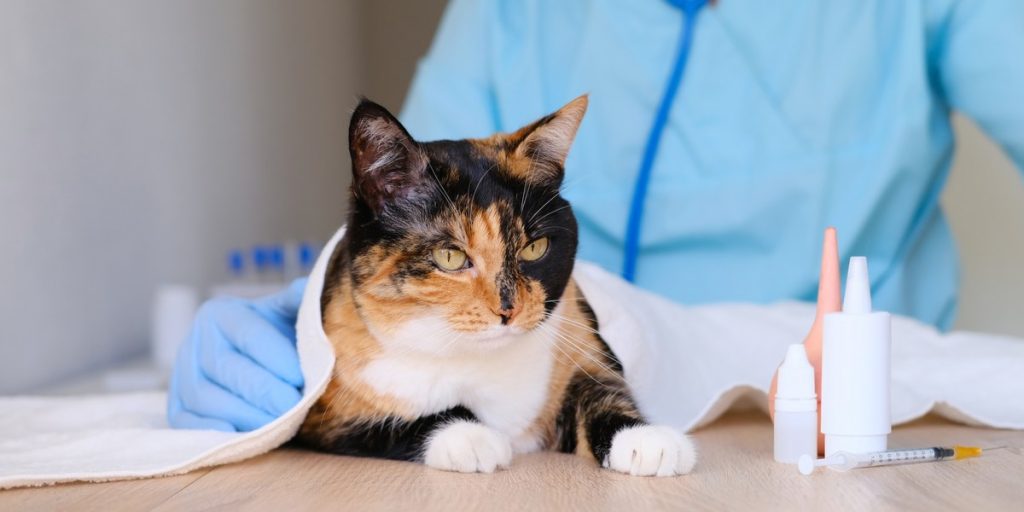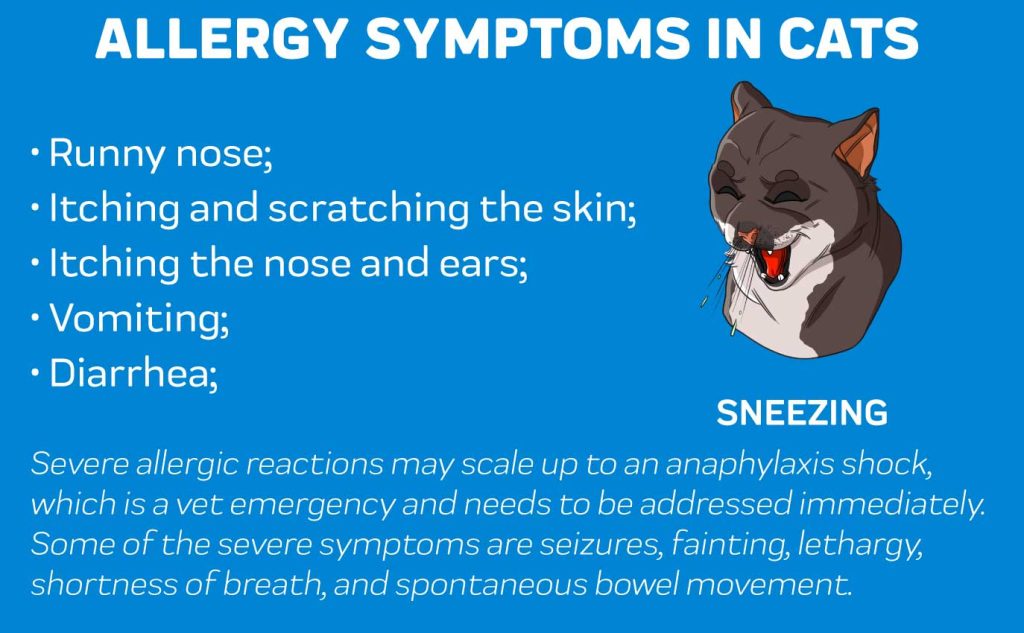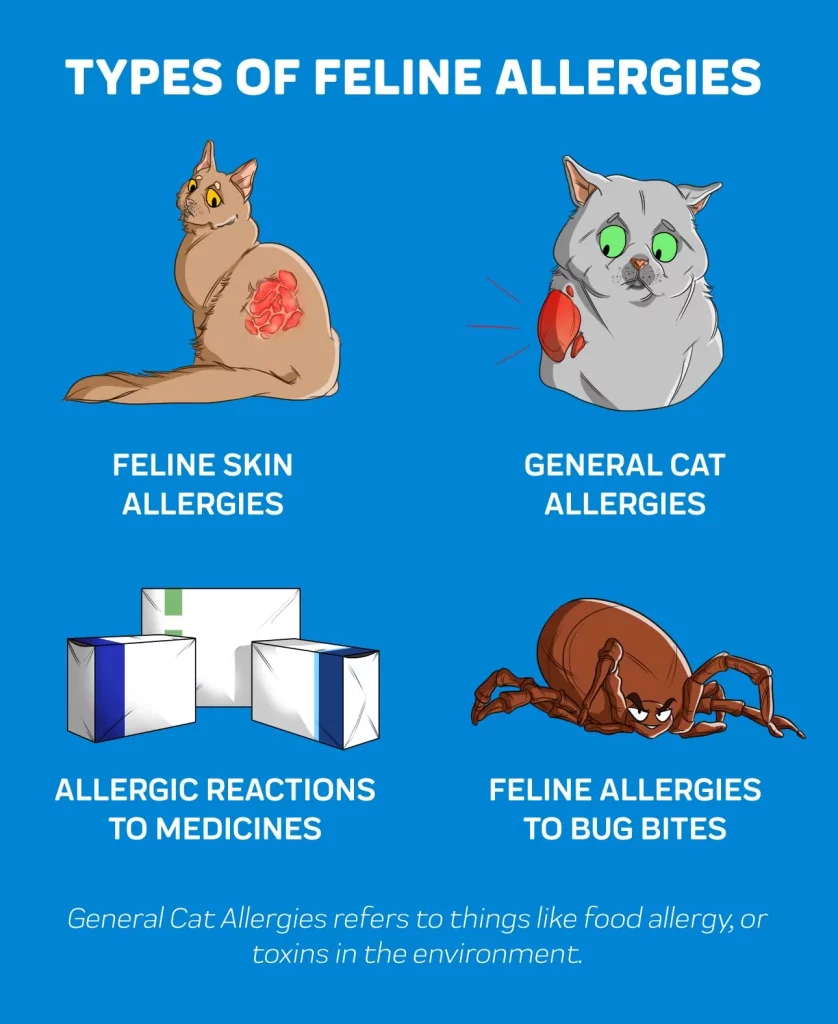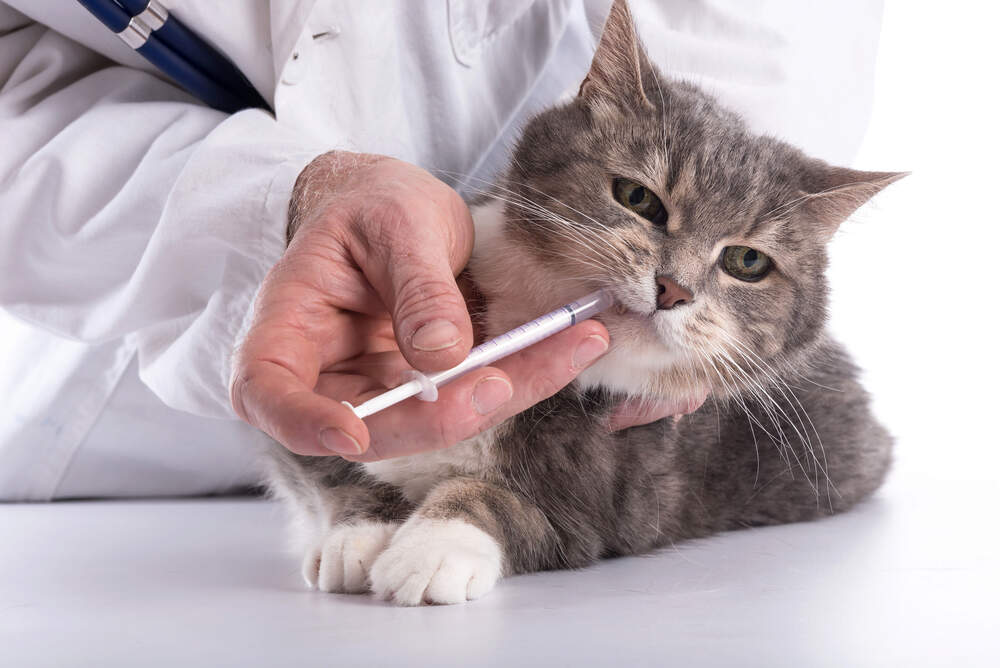Table of Contents
What You Need to Know
What is Cat Benadryl?
Benadryl is a brand name for the drug diphenhydramine hydrochloride, which is a histamine antagonist used to treat hypersensitivity symptoms in cats, including swelling, itching, sneezing, and hives resulting from insect bites or stings, contact with environmental allergens such as grass or pollen, and reactions to flea bites or vaccines.
Benadryl Overview
Medication Type: Antihistamine
Form: Tablet, Liquid
Prescription Required?: No
FDA Approved?: No
Brand Names: Benadryl
Common Names: Diphenhydramine Hydrochloride
Available Dosages: 25 mg
Antihistamines block histamine receptors in the body, which are responsible for triggering cat allergies. Read on to find answers to the most common questions about Benadryl to determine if it is safe.

How does Benadryl for Cats Work?
Benadryl, or its generic form, diphenhydramine, is a histamine antagonist commonly used to treat cat’s hypersensitivity and allergic reactions. Here’s how Benadryl works for cats:
Histamine Antagonist Action:
- Histamines and hypersensitivity reaction.: hypersensitivity reaction. In cats, they are often triggered by the release of histamines. Histamines are substances produced by the body’s immune system in response to an allergen (substances that cause hypersensitivity).
- Blocking Histamine Receptors: Benadryl works by blocking histamine receptors in the body. Histamine receptors are proteins on cells that bind to histamines, triggering allergic symptoms.
Relief from Allergic Symptoms:
- Reduction of Itching and Swelling: By blocking histamine receptors, Benadryl helps reduce pruritus, swelling, and other allergic symptoms. This can be particularly beneficial for cats experiencing skin irritations, pruritus, or other hypersensitivity reactions.
Sedative Effect:
- Central Nervous System Depression: Besides its histamine antagonist properties, Benadryl has a soothing effect. It works by depressing the central nervous system, leading to drowsiness.
- Calming Effect: The sedative effect can help calm a cat, making it useful when stress or anxiety exacerbates allergic symptoms or when sedation is needed.
Motion Sickness:
- Anti-Nausea Properties: Benadryl has anti-nausea properties that can be helpful for cats experiencing motion sickness during travel.
- Reducing Vomiting: It can help reduce vomiting associated with motion sickness, making it a helpful option for cats prone to car-related nausea.
Individual Variation:
- Response Differences: Cats, like humans, can respond differently to medications. Some cats may become slightly sedated, while others may not show a noticeable behavior change.
- Effectiveness: The effectiveness of Benadryl can vary from cat to cat, and it may not be equally effective for all types of hypersensitivity.
Important Considerations:
- Consultation with a Veterinarian: It’s crucial to consult with an animal doctor before administering any medication to your cat. The animal doctor can determine the appropriate dosage based on the cat’s weight, health status, and specific needs.
- Monitoring for Side Effects: While generally considered safe when used appropriately, side effects can occur. Monitoring your cat for adverse reactions and seeking veterinary advice if needed is essential.
In summary, Benadryl for cats primarily works by blocking histamine receptors, relieving allergic symptoms, and inducing a sedative effect that can be beneficial in specific situations. Always follow your animal doctor’s guidance regarding the use and dose of Benadryl for your cat.

The Role of Antihistamines in Addressing Feline Allergies
Antihistamines play a crucial role in addressing feline hypersensitivity by counteracting the effects of histamines, substances released by the immune system in response to allergens. Here’s an overview of the role of histamine antagonists in managing cats with allergies:
Histamine Release and Allergic Reactions:
- Allergen Exposure: Many pets, like humans, can be exposed to allergens such as pollen, dust mites, certain foods, or insect bites.
- Immune System Response: When a cat’s immune system identifies an allergen, it releases histamines as part of the allergic response.
Effects of Histamines:
- Itching and Scratching: Histamines cause blood vessels to dilate, leading to increased blood flow to the affected area. This results in symptoms like pruritus and scratching, common in cats with hypersensitivity.
- Swelling and Inflammation: Histamines also contribute to the swelling and inflammation associated with hypersensitivity reactions.
Antihistamines Mechanism of Action:
- Blocking Histamine Receptors: Histamine antagonists block histamine receptors, preventing histamines from binding to cells and triggering the allergic response.
- Reducing Symptoms: By inhibiting histamine activity, histamine antagonists help alleviate pruritus, redness, and swelling.
Types of Feline Allergies Treated with histamine antagonist:
- Atopy refers to environmental hypersensitivity, and histamine antagonists are often used to manage symptoms related to atopic dermatitis in cats.
- Food hypersensitivity: While histamine antagonists may help relieve some symptoms, they are not as effective for treating food hypersensitivity in cats. Identifying and removing the specific allergen from the diet is crucial.
Considerations for Antihistamine Use in Cats:
- Vet Consultation: Before administering any histamine antagonist the cat would need, it is essential to consult with an animal doctor. The vet can evaluate the cat’s health, identify the specific hypersensitivity triggers, and recommend an appropriate treatment plan.
- Individual Variation: Cats may respond differently to various histamine antagonists, and finding the most effective option may require some trial and error.
- Combination Therapy: In some cases, animal doctors may recommend a combination of histamine antagonists and other medications or treatments for comprehensive hypersensitivity management.
Possible Side Effects:
- Sedation: Some histamine antagonists can cause drowsiness in cats, which may be desirable in certain situations, such as managing stress or travel-related anxiety.
- Dry Mouth: Histamine antagonists can decrease saliva production, resulting in a dry mouth after taking Benadryl.
In conclusion, histamine antagonists are valuable tools in managing feline hypersensitivity, providing relief from symptoms associated with histamine release. However, a comprehensive approach that includes identifying and addressing specific allergens and veterinary guidance is crucial for effective hypersensitivity management in cats.

Why Consulting with your Veterinarian is the First Step?
Consulting with your animal doctor is the safe and effective step when considering any medical intervention for your cat, including using histamine antagonists for hypersensitivity. Here are several reasons why seeking professional veterinary guidance is suitable for your cat:
- Accurate Diagnosis:
- Veterinarians have the expertise to diagnose the cause of your cat’s symptoms accurately. Allergies can have various triggers, including environmental factors, food, or parasites. Determining the specific allergen is crucial for effective treatment.
- Tailored Treatment Plan:
- An animal doctor can create a customized treatment plan based on your cat’s health, age, and the severity of their allergies. Depending on the nature of the allergies, this may involve a combination of histamine antagonists and other medications.
- Proper Dose and Administration:
- Animal doctors can guide the correct dose of histamine antagonist for your cat’s size and condition. Administering an incorrect dose can lead to ineffective treatment or potential side effects.
- Monitoring for Side Effects:
- Antihistamines, like any medication, may have side effects. An animal doctor can educate you on potential side effects to watch for and advise on what to do if any adverse reactions occur.
- Comprehensive Health Assessment:
- Veterinary consultation allows for a thorough examination of your cat’s overall health. Underlying health issues or conditions that may contribute to or exacerbate allergies can be identified and addressed.
- Consideration of Individual Variability:
- Cats can respond differently to medications. An animal doctor considers your cat’s characteristics, including age, breed, and existing health conditions, to choose the most suitable histamine antagonist and dose.
- Monitoring Treatment Efficacy:
- Regular check-ups with an animal doctor enable monitoring of the treatment’s effectiveness. The treatment plan can be adjusted based on your cat’s response and any changes in their condition.
- Identification of Underlying Issues:
- Allergies may sometimes be a symptom of an underlying health problem. Veterinary consultation can help identify and address these root causes for more comprehensive and long-term solutions.
- Educational Support:
- Veterinarians provide valuable information and guidance on managing your cat’s allergies beyond medication. This may include environmental changes, dietary adjustments, or other strategies to reduce exposure to allergens.
- Safe and Responsible Use of Medication:
- Veterinarians emphasize the importance of using medications responsibly. They can guide you on the safe use of antihistamines, including potential interactions with other medications your cat may be taking.
In summary, consulting with an animal doctor ensures a holistic and tailored approach to managing your cat’s allergies. It promotes the well-being of your feline companion by addressing the specific needs and conditions unique to them. Always seek professional advice before initiating any treatment for your cat’s health.

Is Benadryl Safe for Cats?
Giving your cat Benadryl is safe. However, as with all medications, Benadryl should be used correctly.
It’s best to call your animal doctor to ask about using Benadryl for your cat, as some cats should not take Benadryl, including cats with certain medical conditions (such as heart problems or glaucoma), those taking other medications, pregnant or nursing cats and cats allergic to diphenhydramine.
If you use Benadryl because your cat has an allergic reaction or itchy skin, always contact your animal doctor before giving medication. Benadryl treats a cat’s symptoms (swelling, pruritus, sneezing, hives) but doesn’t treat the underlying cause of the swelling or itching.
For example, your cat may have an allergy to flea bites, but simply treating the cat for the itch without addressing the flea infestation will not cure your cat.

Additionally, cats who scratch and chew due to allergies or another skin condition may need additional medical care to address the pruritus’s primary cause and treat secondary conditions that may have developed, such as skin infections.
In severe allergic reactions (anaphylaxis), many cats experience signs such as facial swelling, difficulty breathing, emesis, diarrhea, lethargy, food allergies, seizures, or collapse.
These severe reactions, caused by wasps, bees, insects, or snake stings, require urgent veterinary attention. Benadryl is not enough to reduce severe allergic reactions.
If your cat has a severe allergic reaction, immediately take him to an animal doctor. If this happens outside of normal business hours and your veterinary clinic is closed, It is suggested to pet parents to take your cat to the nearest emergency veterinary clinic.
Side Effects of Benadryl in Cats
Some experience side effects when a cat is taking Benadryl.
Some common Benadryl side effects you might notice for your pet care include:
- Sedation/drowsiness
- excitement
- Dry mouth
- Difficulty urinating
- Drooling
- Diarrhea
- Vomit
- Runny nose
Signs of unwanted side effects may occur within an hour of Benadryl given to cats.
If you notice your cat exhibiting any of the above signs while taking Benadryl, stop giving the medication and contact your animal doctor to see what you should do.
Although some cats become sleepy when taking Benadryl, others become hyper. For this reason, giving a cat Benadryl for anxiety or to calm down is not recommended.
Different Forms of Cat Benadryl
Unveiling Various Forms of Benadryl Available for Feline Use
Benadryl for cats usually comes in liquid, tablet, or injectable forms. The liquid form may be more convenient for adjusting the dose, especially for smaller cats. However, using a formulation without additional ingredients, such as decongestants or pain relievers, is essential, which can harm your pet.
Again, never administer any medication to your pet without consulting your animal doctor first. They can guide the proper dose, frequency, and form of Benadryl based on your cat’s health needs and medical history. Additionally, your animal doctor may recommend alternative treatments or medications more suitable for your condition, which will be safe for your cat.

Choosing the Right Form of Benadryl Based on Your Cat’s Preferences and Needs
Selecting the proper form of Benadryl for your cat involves considering factors such as your cat’s preferences, ease of administration, and the specific health issue being addressed. Here are some considerations:
- Liquid Form:
- Advantages: Liquid forms are often easier to administer, especially for cats who are difficult to pill. You can mix it with their food or a tasty treat.
- Considerations: Ensure that the liquid formulation is free of additional ingredients that could harm cats. Check with your vet for the appropriate concentration and dosage.
- Tablet Form:
- Advantages: Tablets may be easier to store and measure than liquids. Some are formulated to be palatable and can be hidden in treats or soft food.
- Considerations: Cats can be notoriously tricky to pill. If your cat refuses to take pills, you may need to explore other options.
- Injectable Form:
- Advantages: Injectable forms are administered by a vet and can be helpful in emergencies.
- Considerations: Injections should only be given by professionals. They are not for at-home use. Injectable Benadryl is generally reserved for severe allergic reactions.
- Flavored Versions:
- Advantages: Some formulations come in flavored versions that cats find more palatable.
- Considerations: Ensure that any added flavors are safe for cats and that the formulation meets your veterinarian’s recommendations.
- Consult with Your Vet:
- Advantages: Your veterinarian knows your cat’s health history and can recommend the most suitable form and dose.
- Considerations: Always consult with your veterinarian before giving your cat any medication. They can guide you on the best choice based on your cat’s needs and preferences.
Remember, following your veterinarian’s recommendations precisely is crucial, as an incorrect dose or formulation could harm your cat. Additionally, your vet may explore other treatment options depending on your cat’s specific health condition.
Effective Ways to Administer Benadryl to Your Cat
Administering medication to a cat can be challenging, but there are several effective ways to give Benadryl to your cat:
- Liquid Formulation:
- Use a syringe to measure the prescribed amount of liquid Benadryl.
- Gently hold your cat and insert the syringe into the side of the mouth, aiming for the back of the throat.
- Administer the medication slowly to allow your cat to swallow.
- Hide in Food:
- Mix the prescribed dose of liquid Benadryl into a small amount of wet cat food or a treat.
- Ensure that your cat consumes the entire portion to receive the total dose.
- Pill Pockets:
- Pill pockets are treats designed to conceal medication. Insert the pill or tablet into the pocket and give it to your cat.
- Ensure your cat consumes the entire treat to receive the medication.
- Crush and Mix:
- If your vet approves, you may crush a tablet and mix it with a small amount of wet cat food or a treat.
- Ensure your cat eats the entire portion to receive the total dosage.
- Professional Administration:
- In some cases, your veterinarian may administer Benadryl through an injection. This is typically done in a veterinary clinic.
- Follow your vet’s instructions and schedule any injections.
- Ask for a Flavored Version:
- Some pharmacies or compounding pharmacies can provide flavored formulations of medication that might be more palatable to your cat.
- Confirm with your veterinarian whether this is a suitable option.
- Consult a Veterinary Behaviorist:
- If your cat is tough to medicate, consult a veterinary behaviorist for additional strategies and training techniques.
Always follow your veterinarian’s instructions regarding the dosage and frequency of Benadryl administration. If you encounter difficulties, don’t hesitate to contact your veterinarian for guidance. Ensuring that your cat receives the appropriate medication to address their specific health needs is crucial.
Benadryl Overdose
Although Benadryl is typically considered safe for cats, it is possible to overdose your cat on Benadryl. Avoid administering a lethal dose of Benadryl by weighing your cat before administering the medication and only administering the recommended Benadryl.
Never give more than 1 mg of Benadryl per pound of body weight; never give Benadryl more frequently than every eight hours in 24 hours. Giving more than the recommended dose of Benadryl or giving too many doses within 24 hours increases the risk of Benadryl overdose in cats.
As with all medications, use Benadryl carefully and cautiously and always under the guidance of your veterinarian.
Common side effects of Benadryl overdose in cats may include one or more of the following:
- Rapid breathing
- Slow breathing
- Difficulty breathing
- Rapid heartbeat
- Seizures
- Unconsciousness
- Death

How much Benadryl can I give my cat?
You can purchase Benadryl over the counter at most pharmacies, grocery stores, and department stores. Benadryl is sold as a tablet or liquid. It is essential only to use pure Benadryl.
The only active ingredient should be diphenhydramine HCl. Never use combination medications (e.g., diphenhydramine in combination with a decongestant).
The typical dosage of Benadryl is 1 milligram per pound of body weight. Depending on what Benadryl is being used for, cats can take Benadryl up to three times per day (every eight hours in 24 hours). Consult your veterinarian to find out how often your cat can safely take Benadryl.
Benadryl tablets are available in 25 mg. If your cat weighs 12.5 pounds (give or take a pound or so), you can cut a tablet in half and give it to your cat.
It becomes more difficult for cats that weigh much less than 12.5 pounds or more than 12.5 pounds (unless your cat is significant – a 25-pound cat can take a whole 25 mg tablet of Benadryl ).
Liquid Benadryl may be easier to dose and administer to a cat (cats are notoriously difficult to swallow pills).
Your vet may sell special liquid Benadryl to cats, or you can use Benadryl for children. Be sure to consult your veterinarian to ensure that all inactive ingredients in over-the-counter liquid named diphenhydramine are safe for dogs and cats.
How to give Cats Benadryl?
When giving Benadryl tablets, hold your cat on your lap or place him on a table. Gently point your cat’s head toward the ceiling, open your cat’s mouth by placing a finger on its lower teeth, and quickly place the pill as far down its throat as possible.
Then, have your cat close his mouth and gently stroke him under the chin to encourage him to swallow the pill. Keep your cat’s mouth closed until he has swallowed the pill.
If you are administering liquid Benadryl, use the dosage syringe included in the package to measure the correct dose of Benadryl.
Position the syringe precisely in her mouth, behind one of her canine teeth. Aim the syringe far back into the mouth at the back of the tongue, then gently and slowly inject the liquid into your cat’s mouth, giving him time to swallow and breathe.
Whether you give tablets or liquid, blowing gently on your cat’s face and nose can help encourage your cat to swallow Benadryl. Alternatively, you can hide a tablet or mix liquid into food.
Cats generally dislike Benadryl’s taste, whether it comes in liquid or tablet form. Consider working with a compounding pharmacy that may be able to produce a liquid Benadryl in a flavor that cats like. If you want to go this route, ask your veterinarian to recommend a compounding pharmacy.
Benadryl Dosage Chart for Cats
Cat Weight Benadryl (mg) Liquid (12.5 mg per 5 ml) Tablets (25 mg)
6 pounds 6mg 2.5ml 1/4 tablet
8 pounds 8mg 3ml 1/4 tablet
10 pounds 10mg 4ml 1/4 tablet
12 pounds 10mg 4ml 1/2 tablet
15 pounds 15mg 6ml 1/2 tablet
20 pounds 20mg 8ml 1/2 tablet
25 pounds 25mg 10ml one tablet
Calculate your cat’s dosage.
Find out the exact amount of Benadryl your cat needs to avoid an overdose.
Use Benadryl safely
Benadryl can safely and effectively help if your cat is pruritus, sneezing, or swelling. Although Benadryl is easy to obtain and give to your cat at home, you must get your cat to veterinary care as soon as possible.
This article is informational and is not a substitute for professional veterinary care. Always speak to your veterinarian if you have any questions about your pet’s health. Don’t hesitate to seek professional veterinary advice because of something you read online.
FAQs
Q: Can I give my cat Benadryl for its allergies?
A: Yes, Benadryl is often used to treat allergies in cats. It can help relieve symptoms such as itching, sneezing, and hives.
Q: How much Benadryl can I give to my cat?
A: The recommended Benadryl dosage for cats is 1 mg per pound of body weight, given 2-3 times daily. However, it’s essential to consult with a veterinarian to determine the appropriate dosage for your cat.
Q: Is Benadryl safe for my cat?
A: Benadryl is considered safe for cats when used appropriately and under veterinary guidance. However, following the correct dosage and monitoring for any adverse side effects is crucial.
Q: What are the potential side effects of Benadryl in cats?
A: While Benadryl is generally safe, it can cause side effects in some cats. These may include drowsiness, dry mouth, gastrointestinal upset, and, in rare cases, more severe side effects. It’s essential to be aware of these and seek veterinary advice if any occur.
Q: Can Benadryl be toxic to cats?
A: Benadryl is considered safe for cats in the correct dosage. However, administering too much Benadryl can lead to toxicity. It is crucial to adhere to the recommended dosage and seek veterinary guidance when in doubt.
Q: How do I know if my cat needs Benadryl for its allergies?
A: If your cat is exhibiting symptoms of allergies, such as excessive scratching, hair loss, sneezing, or skin irritation, it may benefit from Benadryl. However, consulting with a veterinarian for an accurate diagnosis and treatment plan is essential.
Q: Can I use Benadryl to treat my cat’s flea allergies?
A: Benadryl may help alleviate the symptoms of flea allergies in cats, but it’s essential to address the underlying cause and use flea control measures in conjunction with any medication. Veterinary advice is crucial for a comprehensive treatment approach.
Q: What should I do if my cat experiences adverse side effects from Benadryl?
A: If your cat exhibits adverse side effects after taking Benadryl, such as difficulty breathing, severe drowsiness, or vomiting, seek immediate veterinary attention. It’s essential to act swiftly in such situations.
Q: Is it common for cats to have allergic reactions to Benadryl?
A: Allergic reactions to Benadryl in cats are uncommon but can occur. Symptoms may include facial swelling, hives, or difficulty breathing. If you suspect an allergic reaction, contact your veterinarian promptly.
Q: Can I use Benadryl as a long-term treatment for my cat’s allergies?
A: Benadryl can be used to manage certain allergic conditions in cats, but it’s best to explore long-term solutions and address the root cause of the allergies. Consulting a veterinarian will help determine if Benadryl is suitable for ongoing use and what additional treatments may be necessary.
Benadryl, a brand name for the drug diphenhydramine hydrochloride, is an antihistamine used to treat allergy symptoms in cats , including swelling, itching, sneezing, and hives resulting from insect bites or stings, contact with environmental allergens such as grass or pollen, and reactions to flea bites or vaccines .